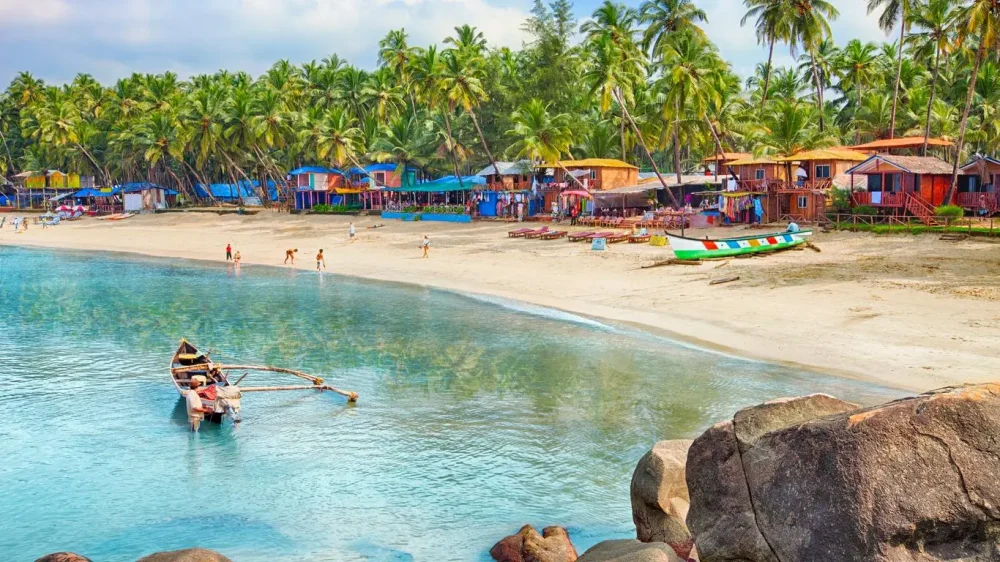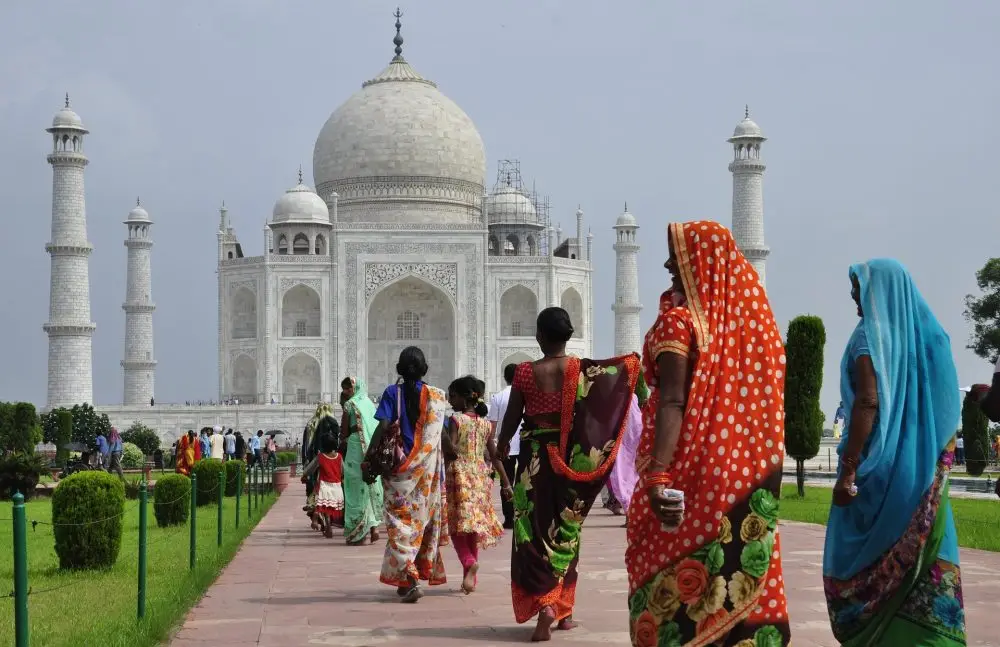India’s tourist geography encompasses coastal zones, mountain ranges, cultural valleys, desert oases and forest plateaus. India’s resorts are not limited to beaches alone. They form a mosaic picture where each region reveals its own climate, rhythm and holiday rituals. Ayurvedic practices, ocean walks, meditation retreats and trekking routes in the Himalayas are equally in demand here.
Coastal area: ocean, sand and sunsets
India’s coastal resorts form a recognisable image of a South Asian holiday: palm trees, beaches, an endless horizon, and sunset rituals. Each zone brings its own philosophy.

South Goa: peace and freedom

South Goa operates in a slow-life format. The beaches here are almost empty, and the infrastructure is built into the natural landscape. Local hotels are not towering, but hide in the shade of palm trees. Agritourism and organic food are the trademarks of the resort. The resort forms the atmosphere of a retreat in India: yoga at dawn, evening bonfires, huts on the beach without concrete. Seafood comes straight from the boats, restaurants prepare dishes in ovens. The complex becomes a space to restore balance and silence.
Varkala: holiday on the cliff
Varkala in Kerala is not like the classic resorts of India. The beaches here lie under a high rocky cliff and the hiking trails stretch along the edge of the cliff. The view of the ocean is like a vantage point. The place offers ayurvedic clinics, massage parlours, yoga schools, tea terraces. The beaches are not crowded, the climate is mild and the waves rise only in the evening.
Himalayas: mountain retreats and the healing air of Indian resorts
India’s mountain resorts create holidays without the heat, noise and overheated beaches. Here, fresh air from spruce slopes is inhaled, snow-capped peaks are visible from the windows, and programmes include hiking trails and breathing techniques.
Rishikesh: the capital of yoga
Rishikesh is embedded in the landscape of the Himalayas. The Ganges flows through the city, with ashrams, bridges and meditation terraces along its banks. The resort offers week-long and month-long programmes of yoga intensives, mantra courses, Ayurveda consultations. Meals are based on a plant-based diet. Local practices do not turn into shows, but retain the essence – deepening into the rhythm of breathing and silence. The complex operates without alcohol, fast food and night entertainment. Holidays are based on the rhythm of the body, not events.
Dharamsala: Tibetan energy and mountain vistas
The resort is famous not only for nature, but also for the spiritual history of India. The residence of the Dalai Lama, Buddhist monasteries, meditation schools are located here. Tourists choose trekking, retreats, philosophy lectures. The format creates a space of silence and inner work. Rooms have no TVs and the menu includes lentil soups, raw honey and Tibetan flatbread. The air is scented with incense and pine trees.
Rajasthan: sands, palaces and traditions
India’s Rajasthan resorts are reshaping the perception of a desert holiday. Here one does not bathe in the sea, but dissolves in an atmosphere of history, colour and sound. The architecture is reminiscent of Arabian fairy tales, the service is based on the rituals of hospitality, and holidays satiate the eye and ear rather than the body.
Udaipur: lake oasis and architectural symphony
The city is called the Venice of the East and is situated on the shores of Lake Pichola and Lake Fateh Sagar. The water surface reflects the domes of palaces and boats cross the city’s canals. The region offers the format of “palace accommodation”: rooms in old hotels, dinners on terraces, sitar concerts in the evenings. Udaipur creates a sense of time out of time.
Jaisalmer: holiday in the heart of the desert
The resort is embedded in the landscape of Thar, India’s golden desert. Guest houses are built in ancient forts and camel safaris are combined with overnight stays under the stars. The place refuses noise and replaces it with the rustle of sand. The local cuisine is spicy curries, flatbreads and masala tea. Tourists participate in kalbelia dances and handicraft workshops.
Andaman Islands: India’s resorts off the mainland
India’s Andaman resorts take your holiday to a different rhythm. There are no motorways, no hustle and bustle, no high-rises. Instead, there are white sands, mangrove forests and coral reefs.
Havelock: clear water and the rhythm of silence
Havelock is built around the beaches of Radanagar and Vijayathan. The sand squeaks under bare feet, the water does not get murky even in deep water. A ‘seamless presence’ format is developing here: no loud music, no concrete promenades. Local boats take you to snorkelling, diving and sea cow watching spots. Havelock works as a place where the natural frequency is restored.
Neil Island: a meditative rhythm
Neil Island is rejecting globalisation. There are no chain hotels here, cafes are family-run, and tourists get around on bicycles. The resort offers a life without a schedule: waking up with the sun, walking among the palm trees, fishing, reading, evening by the fire. Locals perform rituals of greeting by the water, and each day starts without an alarm clock.
Contrasting combinations: mountains, ocean and culture
The resorts of India surprise not only with the landscape, but also with its change of scenery. Here you can see the Himalayas, the desert and the sea in one day. Such contrast makes the holiday multi-layered.

Kudremukh: mountain reserve and coffee plantations
Kudremukh is located in Karnataka, within the national park of the same name. The mountains here are covered with tropical forests. The place offers eco-trails, overnight stays in tree houses and excursions to coffee farms. Bison silhouettes can be seen in the morning mist, and bird cries can be heard at night. Kudremukh creates a holiday without a schedule – in time with nature.
Pondicherry: the French footprint and the ocean breeze
The region retains the atmosphere of the colonial South. White facades, French bakeries, narrow lanes – yet the warm ocean is a five-minute walk away. The complex offers windsurfing lessons, cookery classes and architectural tours. Morning market, afternoon heat, evening coffee on the terrace – that’s how a holiday in Pondicherry is structured.
Conclusion
 Resorts in India shape not a location but a way of life. Here they create a space of choice. Beach or temple, meditation or trekking, palace or hut – each format fits into a cultural context. India refuses to be divided into ‘holiday’ and ‘experience’. Every activity becomes a ritual and every destination a route of self-observation, wellness or reboot.
Resorts in India shape not a location but a way of life. Here they create a space of choice. Beach or temple, meditation or trekking, palace or hut – each format fits into a cultural context. India refuses to be divided into ‘holiday’ and ‘experience’. Every activity becomes a ritual and every destination a route of self-observation, wellness or reboot.
 en
en  ar
ar  de
de  es
es  fr
fr  nl
nl  hi
hi  it
it  pt
pt  el
el 



